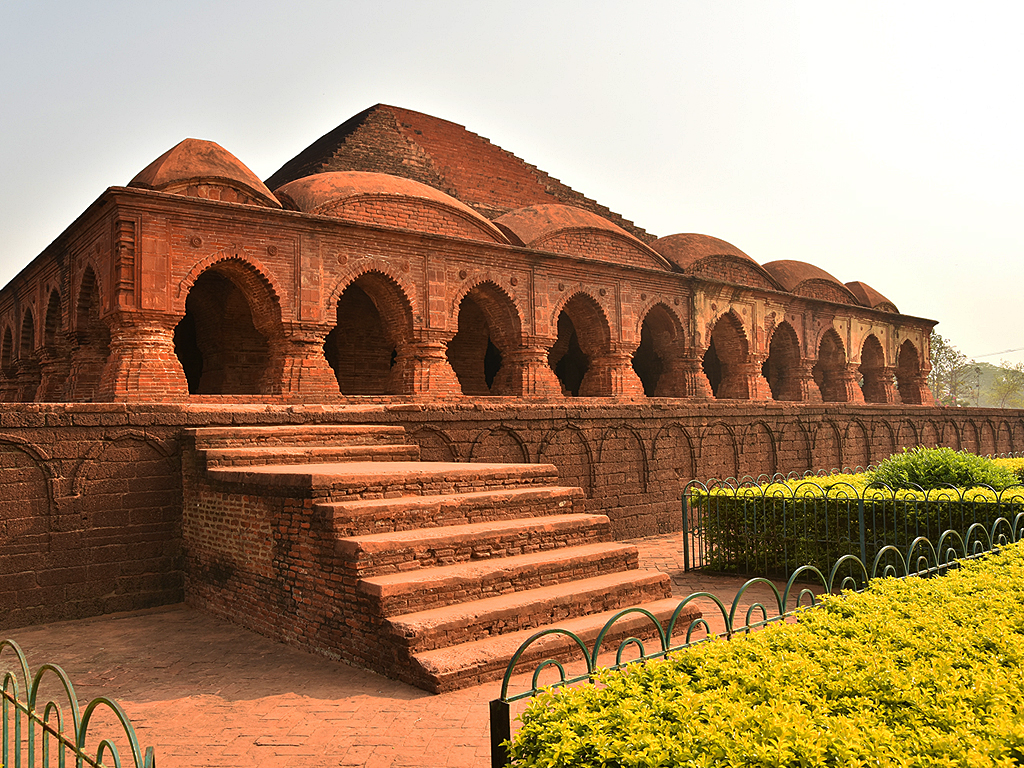We often hear and read the word terracotta in context of temple structures and sculptures. Terracotta is a type of fired clay, typically of a brownish-red colour and unglazed, used as an ornamental building material and in modelling.

In archaeology and art history, “terracotta” is often used to describe objects such as figurines not made on a potter’s wheel. Vessels and other objects that are or might be made on a wheel from the same material are called earthenware pottery; the choice of term depends on the type of object rather than the material or firing technique.
Indian sculpture made heavy use of terracotta from as early as the Indus Valley Civilization (with stone and metal sculpture being rather rare), and in more sophisticated areas had largely abandoned modeling for using molds by the 1st century BC. This allows relatively large figures, nearly up to life-size, to be made, especially in the Gupta period and the centuries immediately following it. Several vigorous local popular traditions of terracotta folk sculpture remain active today, such as the Bankura horses.
In west Bengal many temples are built with terracotta technique, mostly because of easy availability of clay. When discussing Bengal terracotta temples, the first name that automatically comes to mind are the famous ones at Bishnupur. West Bengal is scattered with many such beautiful terracotta temples that are spread across the state; though, sadly, many of them are in a dilapidated condition owing to complete neglect and apathy. Among the rather unique terracotta temples of this state are the Char Bangla temple and the Gangeswar temple, both situated in Baranagar in Murshidabad district.
Baranagar, once the capital of Rani Bhavani of Natore (1716-1795) falls in the Murshidabad district. Under the Rani, Natore was at that time considered among the wealthiest of all Bengal zamindaris, with an annual income of 1.5 crores, a part of which the queen donated towards various charitable causes. While shifting her capital to the western side of the river Ganges, Rani Bhavani decided to build 108 Siva temples in Baranagar, with the aim of turning the place into a second Varanasi. Built between 1753 to1760, many of the temples built by the queen are now lost owing to a change in the course of the river Bhagirathi that engulfed the structures. Among the ones that survived are a cluster of four two-chala temples known commonly as the Char Bangla temple, and the other is a jor bangla temple known as Gangeswar temple, and both are under the purview of the ASI.

The Char bangla temple stands on a 1.5 feet high base, with its four temples showing two roofed Bengal chala (do chala), thus giving it the name of Char bangla, a unique style not seen elsewhere. There are three doors to each temple, with three shiv-lingas in the sanctums. Of the four, three temples share a common platform, while the northern temple stands separate. The northern temple of the Char Bangla is the richest in terracotta ornamentation, reflecting different episodes of Puranic stories, stories from the Ramayana and Mahabharata, narratives from the Krishna-leela, different forms of the mother goddess, and daily scenarios from the village lives. Among the different plaques on the northern temple there is a beautiful depiction of Shiva sitting on a platform, while his two devotees Nandi and Bhringi are shown busy preparing hookah and bhaang for him. The western temple has a beautiful central arch depicting Ravana. The eastern temple is also unique as it shows stucco works, unlike the terracotta work seen in the others; however, the stucco work was made by etching method, which is found elsewhere too.
About a kilometer away from the Char Bangla stands the Jor Bangla temple also known as the Gangeswar temple. In Bengali, jor means a pair and the Gangeswar Mandir shows two identical ek-bangla mandir style, which gives it the name Jor Bangla. The temple complex comprises of three temples dedicated to Shiva, namely the Gangeswar, Kastureswar, and Nageswar temples. These temples show intricate terracotta ornamentation and rest on three archways. Unlike the Char Bangla temple, in the Gangeswar temple, the spaces above the arches noticeably depict nothing from the epics or Puranas, but show only horses and other floral patterns. However, the temple pillars and walls have exquisite terracotta plaques that depict stories from the Ramayana and Krishnaleela. On one of its pillars is depicted on terracotta the story of Ram offering his eye to goddess Durga. Here the mother goddess is with innumerable hands, which is a rarity in temple sculptures.
One Response